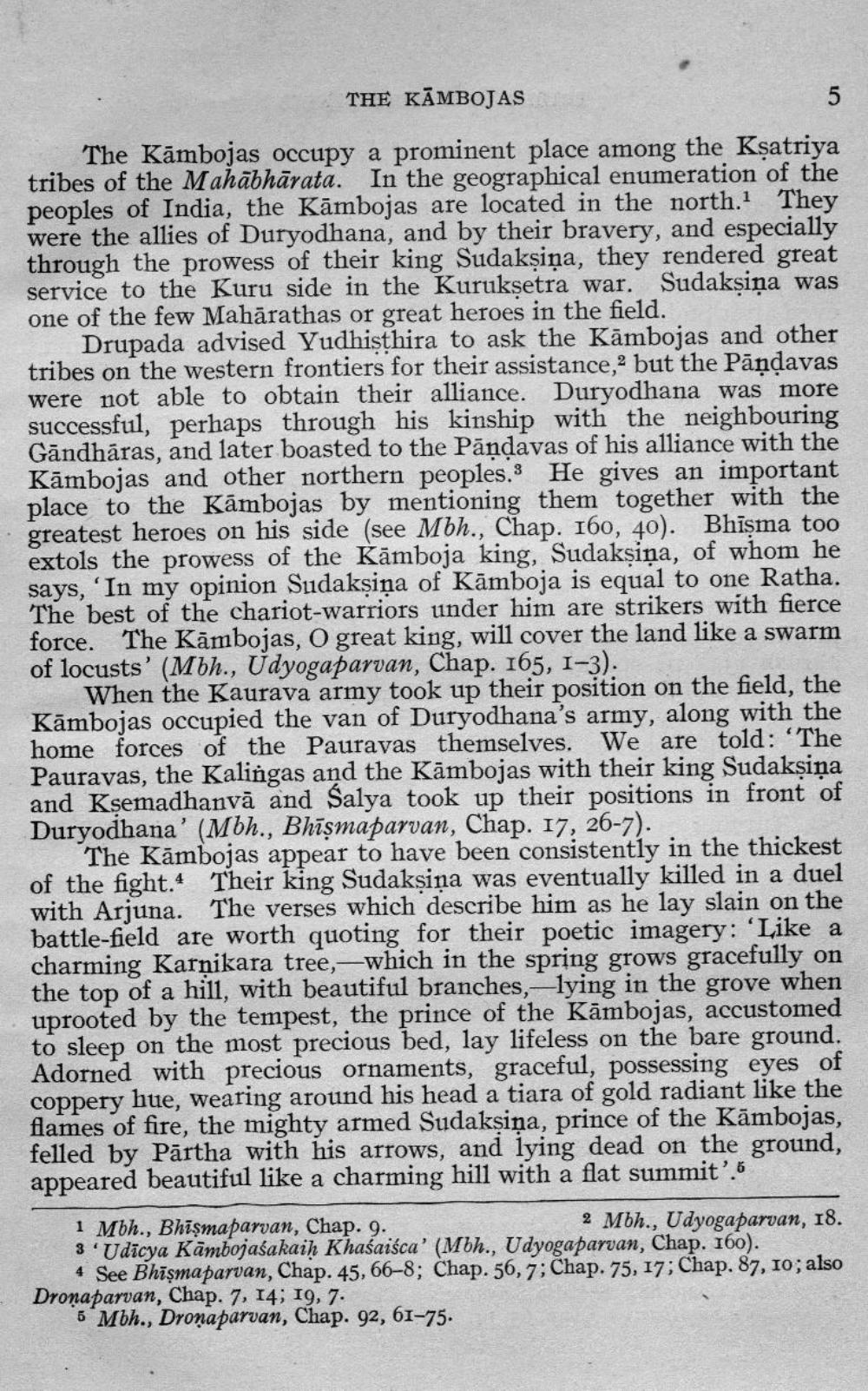________________
THE KĀMBOJAS
The Kāmbojas occupy a prominent place among the Ksatriya tribes of the Mahābhārata. In the geographical enumeration of the peoples of India, the Kambojas are located in the north. They were the allies of Duryodhana, and by their bravery, and especially through the prowess of their king Sudakşiņa, they rendered great service to the Kuru side in the Kuruksetra war. Sudakṣiṇa was one of the few Mahārathas or great heroes in the field.
Drupada advised Yudhisthira to ask the Kāmbojas and other tribes on the western frontiers for their assistance, 2 but the Pandavas were not able to obtain their alliance. Duryodhana was more successful, perhaps through his kinship with the neighbouring Gāndhāras, and later boasted to the Pāņdavas of his alliance with the Kāmbojas and other northern peoples. He gives an important place to the Kāmbojas by mentioning them together with the greatest heroes on his side (see Mbh., Chap. 160, 40). Bhīşma too extols the prowess of the Kamboja king, Sudaksiņa, of whom he says, 'In my opinion Sudakşiņa of Kāmboja is equal to one Ratha. The best of the chariot-warriors under him are strikers with fierce force. The Kāmbojas, O great king, will cover the land like a swarm of locusts' (Mbh., Udyogaparvan, Chap. 165, 1-3).
When the Kaurava army took up their position on the field, the Kāmbojas occupied the van of Duryodhana's army, along with the home forces of the Pauravas themselves. We are told: "The Pauravas, the Kalingas and the Kāmbojas with their king Sudaksiņa and Ksemadhanvā and Salya took up their positions in front of Duryodhana' (Mbh., Bhīşmaparvan, Chap. 17, 26-7).
The Kāmbojas appear to have been consistently in the thickest of the fight.4 Their king Sudaksina was eventually killed in a duel with Arjuna. The verses which describe him as he lay slain on the battle-field are worth quoting for their poetic imagery: 'Like a charming Karnikara tree, which in the spring grows gracefully on the top of a hill, with beautiful branches, lying in the grove when uprooted by the tempest, the prince of the Kambojas, accustomed to sleep on the most precious bed, lay lifeless on the bare ground. Adorned with precious ornaments, graceful, possessing eyes of coppery hue, wearing around his head a tiara of gold radiant like the flames of fire, the mighty armed Sudaksiņa, prince of the Kāmbojas, felled by Pārtha with his arrows, and lying dead on the ground, appeared beautiful like a charming hill with a flat summit's 1 Mbh., Bhīşma parvan, Chap. 9.
2 Mbh., Udyogaparvan, 18. 3 'Udicya Kāmbojaśakaih Khaśaiśca' (Mbh., Udyogaparvan, Chap. 160).
4 See Bhīşmaparvan, Chap. 45, 66-8; Chap. 56,7; Chap. 75, 17; Chap. 87, 10; also Dronaparvan, Chap. 7, 14; 19, 7.
5 Mbh., Dronaparvan, Chap. 92, 61-75.




